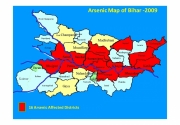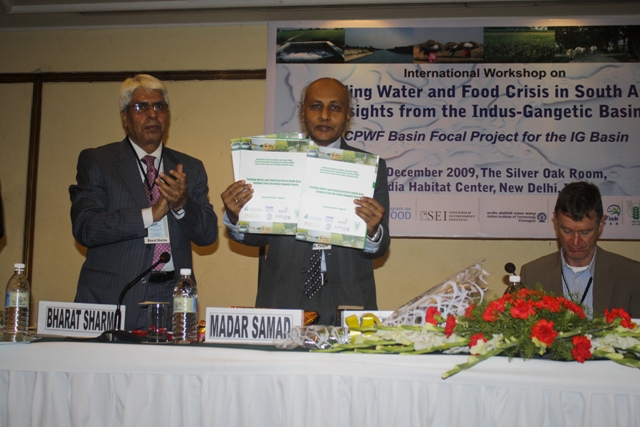Deep Aquifers
Salt water intrusion in coastal aquifers - A research report by National Institute of Hydrology
Posted on 26 Jun, 2010 01:18 PMIn the study saltwater intrusion processes in a hypothetical homogenous and multi-layered coastal aquifer system are simulated using the United States Geological Survey (USGS) finite element model for saturated-unsaturated fluid density-dependent groundwater flow with energy transport of chemically reactive single species solute transport (SUTRA) for different boundary conditions and aquifer parameters.
The saltwater intrusion profiles for steady-state or transient conditions are obtained and analyzed. The effects of changes in the permeabilities of aquifers and aquitards, changes in the influx at the boundary, and changes in dispersivities in medium on the saltwater intrusion process are investigated.
Effect of anisotropy on seepage from a water body – A research report by National Institute of Hydrology
Posted on 26 Jun, 2010 12:59 PMThe report summarizes aspects of the theory of anisotropic flow in porous media and reviews the methodology for computing hydraulic potentials in an unconfined aquifer system. An algorithm has been devised by applying appropriate transformation techniques for anisotropic domain.
Numerical experiments have been performed using the algorithm to compute hydraulic potentials in certain hypothetical anisotropic aquifer systems. A number of cases have been studied with different coefficients of anisotropy for the aquifer as well as the angle inclination of the bedding planes of the soil strata. The simulated hydraulic potentials in the anisotropic domain are established as equipotential lines in vertical sections.
Hydrological problems of hard rock regions: A state of art report by the National Institute of Hydrology
Posted on 25 Jun, 2010 07:32 PMThe study presents a status report on hydrological problems of hard rock areas related to hydrological network design, groundwater quality, failure of open and borewells, regional flood formulae, groundwater balance studies, reservoir sedimentation, hydrological aspects of droughts, forest hydrology and drainage problems of black soil of the hard rock terrain.
In remembrance of water: How a conglomeration of mining companies, politicians and real estate developers are endangering the vast aquifers that give Goans their water
Posted on 07 Jun, 2010 01:00 PM Author: Hartman de Souza Art: Jessica Schnabel Content Courtesy: Himal Southasian
Author: Hartman de Souza Art: Jessica Schnabel Content Courtesy: Himal Southasian
Where there is water, there is probably ore beneath.
Having trekked several times to Paikdev’s spring to gulp water pouring out of the moss-covered iron mouth, one would think the mysteries of the journey would fade. But, if anything, they have become more poignant – sitting here at this shrine to the snake deity of the Velip community in the village of Maina, in Goa’s Quepem District. It is here, amidst thousands of hectares of rolling forests, in the foothills of the Western Ghats, home to countless perennial springs and streams, wildlife and more, that a strange conglomeration of mining companies, politicians and real-estate developers are sharpening their collective sword. These activities were already afoot a year ago, with mining operations systematically destroying forests, because, as the government in Panjim stated at the time, the iron ore was needed by New Delhi to keep its nine-percent growth rate on track. This year, the message is no different.
Arsenic contamination of groundwater in Bihar and mitigation strategies - A research study
Posted on 12 May, 2010 11:24 PM This presentation deals with the problem of arsenic contaminated aquifers in the Gangetic belt of Bihar and the failure of the state government in tackling the crisis and calls for the establishment of a centralized knowledge & research hub with an understanding of the regional peculiarities to mitigate the crisis.
This presentation deals with the problem of arsenic contaminated aquifers in the Gangetic belt of Bihar and the failure of the state government in tackling the crisis and calls for the establishment of a centralized knowledge & research hub with an understanding of the regional peculiarities to mitigate the crisis.
It traces the origin of arsenic crisis to the switch from use of surface water to groundwater. The health impacts of arsenic poisoning and the factors that aggravate arsenicosis are explained. A total of sixteen districts (fifty-seven blocks) in Bihar are affected by high levels of arsenic in groundwater, in trivalent form, which is a more toxic form of arsenic.
200 ft deep well needed for rain water storage so that it is used to recharge underground water pockets
Posted on 31 Mar, 2010 03:12 PMUse of rain water to recharge quickly the deep under ground water pockets
Present problem:
- Due to urbanization, many a under ground water recharge/enrichment points have be closed/covered/blocked. So, % of water reaching the underground water pockets is reduced to a very great extent.
- Bore wells are dug at a very large number to satisfy the increasing demand for water. Therefore, level of underground water table is going down alarmingly.
- As many the opportunities for the rain water to reach the underground level is blocked almost at all places, even with a little bit of rain, the water will run on the roads & cause artificial flood or water blocking at different points on roads or low laying areas of the Cities. Such floods are causing a lot of traffic jams/road mishaps.Rain water on the road is also damaging the durability of the TAR roads.
Using dried wells to enrich deep level under ground water pockets
Posted on 31 Mar, 2010 02:45 PMBy using dried open wells, we can enrich the Underground water quickly.
In the good old days, open wells used to help the common man in fetching water for all purposes and specially the drinking water. Invasion of pump-sets and specially the deep bore wells have pulled the underground water indiscriminately. Therefore, the water table level of the underground water is continuously going down at a very alarming rate. This fall in the underground water table level has made many a very big and useful water wells dry up. Now they are not in use as people do depend on alternative source of water like bore well water or the tap water drawn from far off river water.
200 ft deep wells , in the corner of roads/parks , needed for rain water harvesting in cities
Posted on 31 Mar, 2010 11:51 AMRAIN WATER HARVESTING AT CITY.
LET US MAKE PLANS TO PRESERVE WATER AND SAVE THE ROADS.
Water is an important and essential commodity to every one which is to be preserved.
AT CITIES.
Need for a comprehensive water database says Dr Anil Singh of ICAR
Posted on 03 Dec, 2009 07:56 AMUnrestricted flow, reproduction and redistribution of data has been a great concern with most of the projects and research establishments in India. As we heard the Secretary of Ministry of Water Resources voice his recommendations on the ways to tackle the looming water crisis, and the steps that the ministry is taking towards this, we thought of first putting down the highlights of the talks raw, before we get back to them in a detailed manner.
While we compile together all the presentations and papers, here' s a quick update on the talks from the first day. On the research challenges for improving the use and productivity of natural resources in India, Dr. Anil Singh, Deputy Director General, Natural Resource Management, Indian Council of Agriculture Research had an interesting observation linking fertilizer use with water consumption in the gangetic basin. It is assumed that both of these factors impact the crop productivity and this needs to be explored further.
He suggests:
- India needs a ground water management policy.
- The issues discussed in the workshop cut across all the basins in the country and have long term implications.
- Gangetic Basin is critical for our food security
- The attempt to reduce the cropping area would be a difficult proposition. We would have to live with it... area under cultivation is poised to increase and we might want to consider technological options like the cultivation of aerobic rice, SRI etc.
- Another answer is mechanization in the agricultural sector. This may enhance efficiency.
- We must consider a shift to precision farming as well.
Two new publications from the IGB project were released today by the Chief Guest at the workshop, U.N. Panjiar, the Secretary to the Ministry of Water Resources, Government of India. Releasing the reports, Mr. Panjiar presented the government's perception of the present water situation along with some statistical data on the water usage. The challenges of food security and water security are global. Climate change has been an increasing concern too. He observes food security, water secutiry and climate change are closely related. The objective of food security cannot be achieved without water security.
U.N. Panjiar releasing the IWMI publications on Indus-Gangetic Basin with Bharat Sharma and Madar Samad

Anil Singh delivering his speech
Mr. Panjiar puts forward the following recommendations, stating that these could possibly help us manage well, the problem of water crisis.
- A comprehensive water database should be developed.
- Assessment of impact of climate change on rescources is required.
- Promotion of citizen and state action for conservation of resources.
- Focus on overexploited areas.
- 15% aquifers in country are overexploite and another 15 are critical. We must increase water reuse by 20%.
- Basin level resource management is essential.
- Irrigation potential crated and irrigation potential utilized must be to the optimal levels.
- In agreement with Simon Cook, he emphasizes that efficiency is an important issue.
- Water, energy and food productivity are closely linked. This relation and interdependence must be explored.
- Remote Sensing techniques are critical in agriculture and basin management.
Government of India has launched a Water Resource Information System and most of the data is being made public under this project! Policy too, is being revised to make most of the data public and it is projected to be launched by the end of current financial year. Launching a National Water Mission of India is also being mulled over. (Read the related documents here)
Stating that it is important to ensure technology transfer to farmers to achieve “more crop per drop” he talks about a project conducted by the ministry in which 5000 demonstrations of relevant farm technologies were given to the farmers. The interim report of this project indicates that use of such technological interventions is important in improving the yield of the crop and improve water efficiency!
Speakers and presentations WHSC 2009 day 1 : Ramaswamy Iyer delivers the keynote address
Posted on 23 Nov, 2009 02:54 AM
The speaker line up for the opening day of the conference has some of the most respected names in the water sector, in India. I have put together resource pages for each of the speaker's profiles and the subject of their talk.






